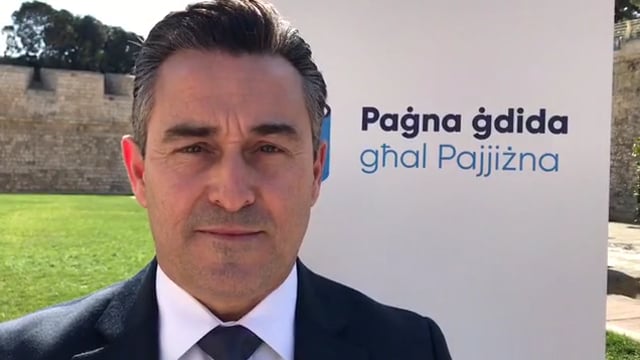[WATCH] PN energy plan: Grech proposes offshore wind farms, second interconnector
Nationalist Party leader Bernard Grech unveils his party’s plan to tap into green energy sources for cleaner air


Updated at 12:24pm with PL's reaction
A future Nationalist government will pursue floating deep sea wind farms and invest in a second interconnector as part of its vision for cleaner energy.
The plan unveiled today by PN leader Bernard Grech and energy spokesperson Ryan Callus has not been costed and details on financials will be fleshed out in the coming months following discussions with stakeholders.
Callus said today’s technology allows floating wind farms to be situated far out at sea where they pose less of a visual intrusion.
The plan also foresees a revised household billing system that allows discounted electricity rates to be calculated over a 12-month period rather than every two months. This will ensure families benefit to the full from the lowest rates of electricity consumption unlike the current situation.
A PN government will rekindle an EU-funding application for a hydrogen-ready pipeline and invest in more electric car charging pillars to push for electrification in transport.
Two short-terms measures will be an increase in the spill-off rate for families that invested in solar panels at home from 7c5 to 10c5, giving them a better rate of return on their investment; and a reduced night-time tariff for the charging of electric cars.
Grech said a PN government will study the Electrogas fixed-term contract and if this is vitiated in any way, including by corruption, it will review the terms.
“As an alternative government, we are obliged to study these contracts and if these contracts can be stopped because they are vitiated, the PN will have an obligation to stop them but as a party that embraces investors we do not want to send out a message that you cannot work with us… work above board, work legally and a PN government will give you all the space to grow, invest and make money,” he said.
The plan, entitled A New Energy Future for Malta 2021-2030-2050, is the first significant policy document unveiled by the PN since Grech became leader.
The PN leader said the intention was to push for cleaner energy generation that will benefit society.
Callus said the PN will provide a holistic long-term plan with “clear and ambitious” targets to achieve the carbon neutrality by 2050.
Reacting to the plan, the Labour Party criticised the Opposition for failing to cost its proposals, describing them as a "collection of ideas, some recycled and others already being implemented".
"This morning, the Opposition leader admitted that he does not know how much the plan he spoke about will cost," the PL said, adding the government had more credibility because it had reduced consumer tariffs, finished the interconnector project and stopped the use of heavy fuel oil.
PN’s six guiding pillars for cleaner energy
1. Cheapest first supply policy
- Every contract the government enters into will seek lower electricity prices. All legal avenues will be explored to review the fixed contract with Electrogas.
- The cheap energy derived from the interconnector will be maximised.
- The ARMS billing mechanism will be reviewed to ensure that household consumption is calculated over a period of 12 months to maximise the benefit families derive from the cheapest tariff bands.
2. Energy efficiency first
- Increase grants for heat pumps, domestic batteries and other energy efficient appliances to support a culture change in industry and households.
- Turn energy performance certificates into effective implementation tools.
- Further investment in energy distribution.
- Feed-in tariffs for domestic and commercial PV panels will, at a minimum be maintained at existing rates and adopt a rolling mechanism to ensure market stability.
- A short-term solution for families whose PV panel contracts expired will be ensure they benefit from a set-off rate of 10c5.
3. Long-term alternative national generation capacity
- Gas turbines have to eventually shift to hydrogen because renewable energy suffers from intermittency and so another attempt to secure EU funds for a hydrogen-ready pipeline will be made.
- Government will identify solutions for solar rights.
4. Electrification of transport
- Invest in network-wide charging stations and infrastructure.
- Invest in an electric mass transit system.
5. Second interconnection to Europe
Build a second interconnector electricity link to a different site in Italy.
6. Wind energy
Invest in floating deep-sea wind turbines at distances of between 10km and 20km from the coast. Scotland and Portugal have invested in these deep-sea floating windfarms, which are unlike the nearshore wind farm originally proposed by the PN government prior to 2013.
















.jpg)





